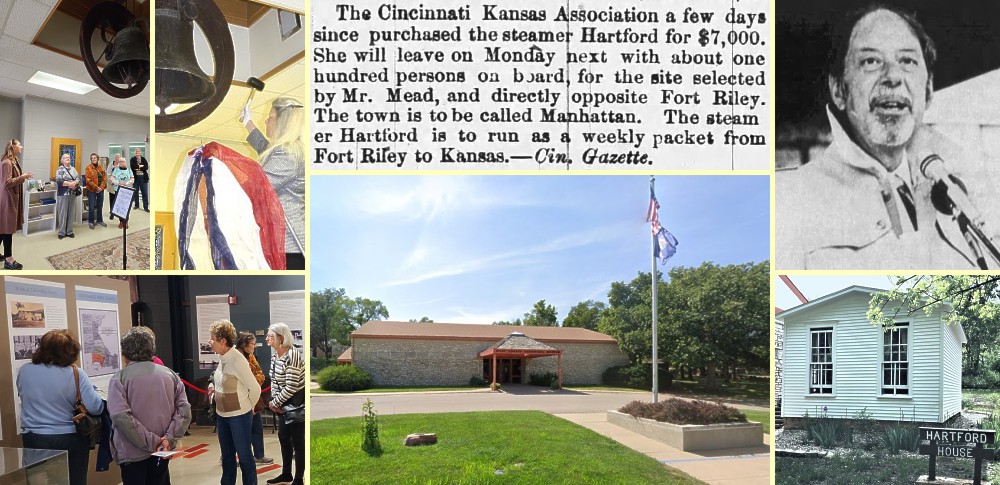Kansas Snapshots by Gloria Freeland - April 18, 2025
"Yesterday’s heritage is tomorrow's future"
Someone in the group asked if the bell had ever been rung. Indeed, it had. On April 9, 2015, local-history-museum director Cheryl
Collins, wearing gloves and wielding a small rubber mallet, had struck it continuously for four minutes.
That question had recently arisen after Katharine Hensler, current Riley County Historical Museum director, drew attention to the
bell hanging from the lobby ceiling. The query had come from a member of the Silver Creek Beneficiary Club (SCBC), which was touring
the newly-renovated building.
Each minute of Cheryl's effort was to recognize one year of our Civil War. The date was the 150th
anniversary of General Robert E. Lee's surrender to General Ulysses S. Grant, which symbolically ended the conflict.
Reaching the bell involved standing on a ladder with her arm above her head. Cheryl later observed, "Four minutes is longer than one
thinks!"
The bell was originally part of the steamboat Hartford, which began its 850-mile trip from Cincinnati on April 26, 1855. Its cargo
was a group of Methodist settlers intent on having Kansas join the Union as a free state. The new village was to be named Manhattan,
since those who financed the boat and the journey were from Manhattan, New York.
The settlers' destination was the confluence of the Kansas and Smoky Hill rivers - the site of present-day Junction City. But after
navigating the Ohio, Mississippi, Missouri, and Kansas rivers, the boat ran aground on June 1. A victim of low water, the trip had
come to an end 30 miles short of its goal, about two miles east of where the Manhattan Town Center is now located.
The passengers discovered a group of like-minded New Englanders here who had founded the village of Boston just two months before.
They invited those on the Hartford to join them. Part of the agreement reached was the settlement would be renamed Manhattan.
The plan had been to use the Hartford to carry local produce to the east and then ferry westward additional settlers and goods needed
on the frontier. But that didn't go as intended either. In October 1855, the Hartford burned while stopped near St. Marys. There was
a tale that Native Americans - unhappy those on board wouldn't give them tobacco - set the dried grass on the nearby banks on fire
and the wind blew cinders onto the boat. The bell was salvaged and hung in the Manhattan Methodist Church for years. It's been on
loan to the museum since the new building was opened in 1977.
So why was I in the museum, listening to Katharine recite a story I was quite familiar with? Yes, I do enjoy history, but as a member
of the historical society board, I also believe it's important to see how we present ourselves to the community and how the
community, in turn, views us.
The SCBC visitors were obviously drawn to photos and artifacts related to Keats and the Wildcat Valley, where most of them - and I -
live. Many were interested in the black-and-white film documenting the 1951 flood that submerged parts of Manhattan and surrounding
communities. Some remember when nearby towns were uprooted to build Tuttle Creek Dam - one of the many built in Kansas and other
states for flood control.
While the Hartford bell question was easily answered, a larger question is more difficult: Why study history? Seeming like a perfect
opportunity for a "past-meets-the-future" moment, I asked Google's Artificial Intelligence program that question. It responded:
Studying history is beneficial because it helps us understand the present and future by examining the past. It fosters critical
thinking, cultural awareness, and the ability to learn from mistakes. Additionally, history provides a deeper understanding of
societal development, human experience, and the evolution of different cultures.
A somewhat similar question was posed at the dedication of the new museum building in 1976 by Kansas Governor Robert Bennett: "Do we
need to spend (taxes) for a heritage that was?" His answer: "Yesterday's heritage is tomorrow's future."
There is a nebulousness to both answers, yet many important things in life - love, happiness, beauty, pleasure - are equally hard to
pin down. PBS's "Finding Your Roots" is unlikely to have any material impact on either its viewers or subjects, yet its popularity is
a testament to the subjective power of knowing about our past.
Another sign of the importance the past plays in our lives is that the county has had to expand the space devoted to the museum four
times in a little more than a century. The Pioneer Log Cabin in City Park, completed in 1916, was built both to show what home looked
like to a settler and to house artifacts of the time. By 1957, it was full and the museum moved to the basement of city hall. It
outgrew that space, prompting the construction of the current building as a U.S. bicentennial project. An addition for more storage
was built in 1986.
Today, with space once again at a premium, only things that relate directly to Riley County's history can be accepted. The renovation
involved painting, better lighting, more "breathing room" between exhibits, adding emphasis on the county's small towns, and creating
a children's interactive area.
So why do we find stories, such as how our town came to be, so captivating? Whatever the answer, seeing the positive reactions of our
visitors, including one who wanted to know how she could make a donation then and there, is evidence enough that knowledge of the
past is important.
